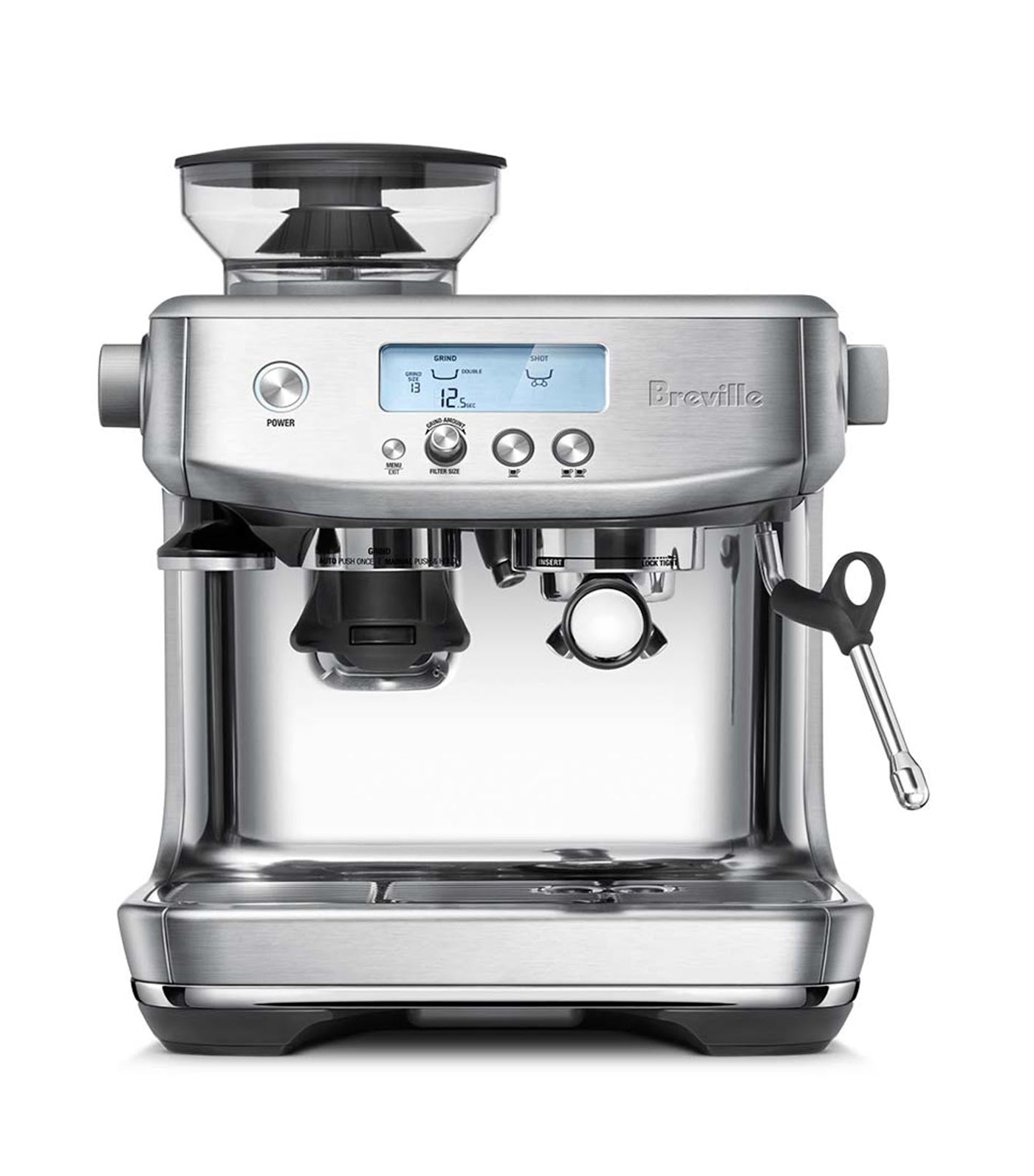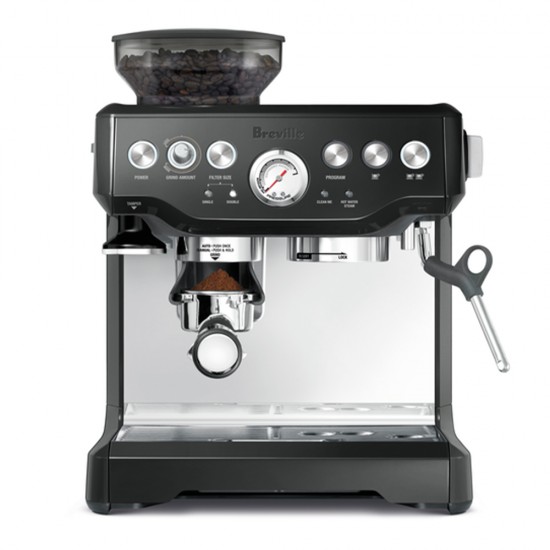#1: Breville Barista Pro

- Fast heat-up time
- Intuitive LCD display for easy operation
- Precise espresso extraction with built-in grinder
#2: Breville Barista Express

- Built-in grinder for fresh coffee
- Affordable for its features
- Solid and durable build quality
As someone who cherishes a perfectly brewed cup of espresso, I’ve tried my fair share of machines. Over time, I realized that an espresso machine isn’t just a kitchen gadget—it’s a long-term investment in daily joy. With that in mind, I set out to compare the Breville Barista Pro and the Breville Barista Express, two machines that are often regarded as some of the best for home baristas. I was determined to find out which one truly lived up to the hype, and my experience with both has given me some key insights.
Barista Pro

Barista Express

Performance: Speed vs. Tradition
When it comes to performance, the Breville Barista Pro quickly earned a special place in my kitchen. The ThermoJet heating system allows it to heat up in just three seconds. Whether I’m rushing to make my morning coffee before work or entertaining guests, this speed is a game-changer. There’s no waiting around for the machine to reach the optimal temperature, which saves time and ensures consistent results.
The Barista Express, while reliable, requires about 45 seconds to heat up, which felt like an eternity once I got used to the Pro. If you’re someone who values speed and convenience, the Pro’s rapid performance gives it a clear edge.
Grinding Experience: How the Machines Handle Beans
One of my favorite parts of brewing coffee is the sound of freshly ground beans, and the grinder is an essential element of any great espresso machine. The Barista Pro's grinder offers 30 settings, giving me incredible control over the grind size. Whether I’m pulling a shot of espresso or preparing a coarser grind for Americano-style coffee, the Pro has the flexibility to meet my needs.
In contrast, the Barista Express has 18 grind settings, which are fine for beginners or casual coffee drinkers but feel limiting when you want to experiment. I often found myself wanting more precision with the Express, especially when trying to achieve that perfect extraction for a rich, crema-topped espresso shot. Know How to change the brew temperature on Breville/Sage Barista Express
Milk Frothing: Crafting Café-Quality Drinks at Home
Milk frothing is where the Breville Barista Pro truly shines. Its four-hole steam wand allows for quicker and more consistent milk steaming. As someone who loves a smooth latte or a frothy cappuccino, I appreciated how easy it was to create microfoam with this machine. It consistently delivers café-quality results, and it took my latte art to the next level.
The Barista Express, with its single-hole steam wand, is slightly less effective. While it still produces decent froth, it takes longer and requires more effort to achieve the same smooth consistency. This was especially noticeable when I was making multiple drinks back-to-back. Idea on How to steam milk on the Breville
Ease of Use: Digital vs. Analog
One thing that really impressed me about the Barista Pro is its digital LCD display. It provides clear, easy-to-follow feedback about brewing time, grind settings, and water temperature. This made experimenting with different coffee styles a breeze. I could fine-tune my settings to achieve the exact taste I was craving.
On the other hand, the Barista Express relies on an analog interface, which feels slightly dated. While functional, it lacks the intuitive guidance of the Pro’s display, making it less approachable for beginners. I remember fumbling with the dials on the Express when I first started using it, which made the learning curve steeper. Learn How to steam milk on the Breville Barista Express
Barista Pro

Barista Express

Taste Test: What’s in the Cup?
At the end of the day, the most important factor is the taste. Both machines produce excellent espresso, but the Barista Pro consistently delivered a richer, more balanced flavor. The finer control over grind size and brewing temperature allowed me to extract the subtle notes of the coffee beans, whether I was using a bright, fruity blend or a darker roast.
With the Barista Express, I found the flavor could be hit or miss, especially when experimenting with different beans. The fewer grind settings and slower heating system sometimes led to inconsistencies in my shots.
Maintenance and Durability
If there’s one area where both machines are evenly matched, it’s maintenance. Both the Barista Pro and the Barista Express come with features like removable drip trays and cleaning alerts, making them relatively easy to keep in good condition.
However, the Barista Pro feels more modern and well-built overall. Its updated design and advanced technology suggest it will remain a reliable companion for years to come. The Barista Express, while durable, feels like it belongs to an older generation of machines and may not have the same longevity in a fast-evolving market. About Using a single basket with a Breville or Sage home espresso machine
Who Should Buy the Breville Barista Pro?
While the Barista Pro is undeniably an investment, I believe it’s perfect for:
- Busy professionals: The quick heat-up time and user-friendly design make it ideal for those who want great coffee without sacrificing convenience.
- Aspiring home baristas: The precise grind settings, digital interface, and steam wand allow for endless experimentation.
- Coffee enthusiasts: If you’re serious about getting the most out of your beans, the Pro offers unparalleled control and consistency.
Who Might Prefer the Barista Express?
The Barista Express still holds its own as a great entry-level machine. It’s a good fit for:
- Budget-conscious buyers: The Express is more affordable and still delivers quality espresso.
- Casual coffee drinkers: If you’re not planning to fine-tune every cup, the Express offers reliable performance without too many bells and whistles.
- Those who enjoy simplicity: Its analog controls and straightforward design make it less intimidating for beginners.
Product Review Conclusion: Breville Barista Pro vs Express
After spending time with both machines, I can confidently say that the Breville Barista Pro is the better choice for anyone looking to elevate their coffee game. Its modern features, speedy performance, and precise controls make it a standout option for serious coffee lovers. While the Barista Express remains a solid entry-level machine, the Pro’s advanced capabilities make it worth the investment.
Ultimately, your choice depends on your priorities. If you’re looking for speed, precision, and a user-friendly experience, the Barista Pro is the way to go. However, if you’re new to espresso or working within a tighter budget, the Barista Express is still a reliable and capable machine. For me, the Breville Barista Pro has become an essential part of my morning routine, and I couldn’t be happier with the results.
Frequently Asked Questions about Breville Barista Pro vs. Express
Q1: What are the main differences between the Breville Barista Pro and Barista Express?
A: The key differences are in their heating systems, user interfaces, and grind settings. The Barista Pro features the ThermoJet heating system, which heats up in 3 seconds, while the Barista Express uses a ThermoCoil system, taking about 45 seconds. The Pro also has a digital LCD interface for easier operation, while the Express uses an analog interface. Additionally, the Pro offers 30 grind settings compared to the Express's 18.
Q2: Is the Breville Barista Pro worth the higher price compared to the Barista Express?
A: Yes, for coffee enthusiasts or those who value convenience and precision, the Barista Pro is worth the investment. Its faster heat-up time, advanced digital controls, and greater grind precision make it a more versatile and efficient machine. However, if you’re on a budget or a beginner, the Barista Express still offers excellent value.
Q3: Which machine is better for beginners?
A: Both machines are beginner-friendly, but the Barista Express might be slightly easier for those new to espresso machines. Its analog controls are straightforward, and the price point is lower, making it a good starting option. However, the Barista Pro’s digital display offers helpful guidance that can simplify the learning curve for beginners.
Q4: How do the grinders compare between the two machines?
A: The Barista Pro's grinder has 30 settings, allowing for finer adjustments and better control over the grind size, which is crucial for perfect espresso extraction. The Barista Express offers 18 settings, which is sufficient for most users but may feel limiting for those who like to experiment with different beans or brewing techniques.
Q5: Can both machines make lattes and cappuccinos?
A: Yes, both the Barista Pro and the Barista Express come with a steam wand for frothing milk, making them suitable for lattes, cappuccinos, and other milk-based drinks. The Barista Pro's four-hole steam wand produces microfoam more quickly and consistently, while the Barista Express has a single-hole steam wand that requires more effort to achieve the same results.
Q6: Are these machines easy to clean?
A: Yes, both machines are relatively easy to clean. They feature removable drip trays, built-in cleaning alerts, and an included cleaning kit. Regular maintenance, like descaling and cleaning the grinder, ensures both machines stay in good working order.
Q7: Do both machines have programmable features?
A: Yes, both machines allow you to customize your coffee. However, the Barista Pro’s digital interface makes programming easier and more precise. You can adjust brewing time, temperature, and grind size with clear feedback on the display, while the Barista Express relies on manual controls.
Q8: Which machine is better for small kitchens?
A: Both machines have a similar footprint, but the Barista Pro has a more modern design that may better complement a small, stylish kitchen. If counter space is a concern, either machine will fit well without dominating your kitchen.
Q9: Can I use pre-ground coffee with these machines?
A: Yes, both machines have a portafilter that can accommodate pre-ground coffee. However, to achieve the best results, it’s recommended to use freshly ground coffee with their built-in grinders.
Q10: Which machine is more durable?
A: Both machines are built to last, with high-quality stainless steel components. However, the Barista Pro’s more modern design and advanced technology suggest it might have an edge in longevity as it’s designed to meet the demands of contemporary users.
